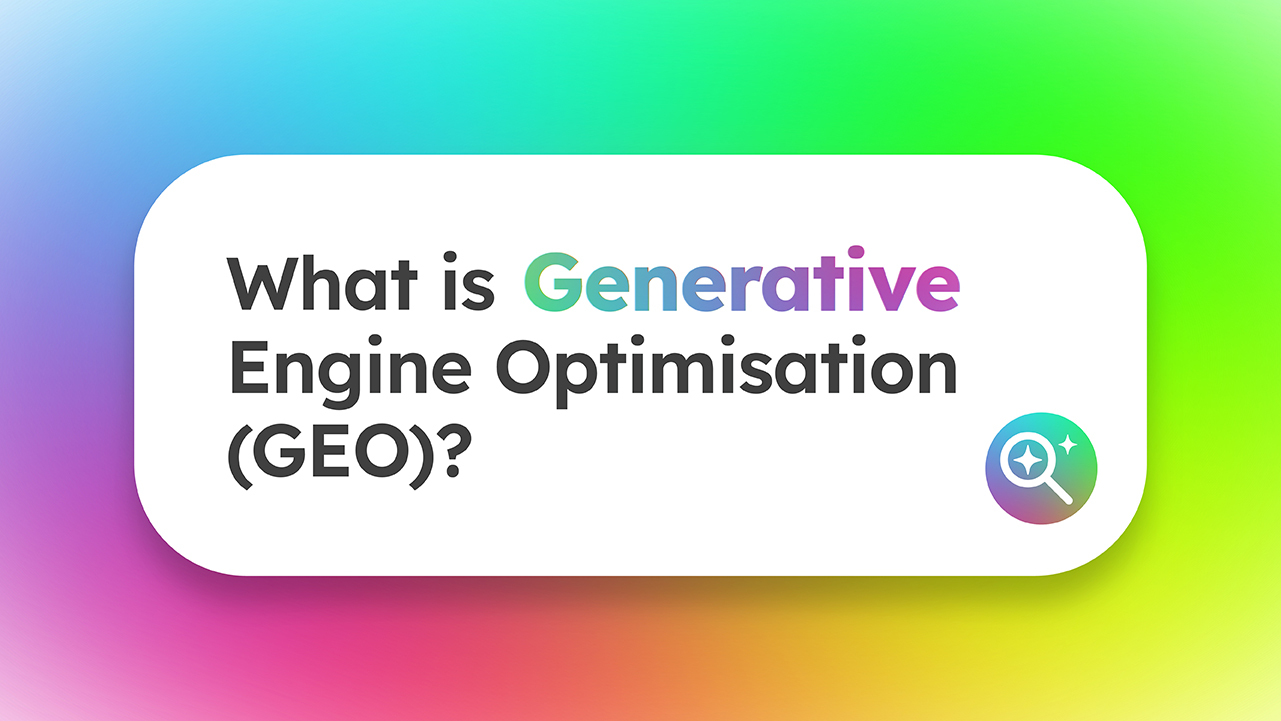Search engines are evolving – and so should your digital strategies.
In recent years, AI Marketing has exploded with the rise of platforms like ChatGPT, Gemini, Perplexity and more. Visibility is no longer just about ranking on Google. Instead, we’ve entered a new era of digital marketing updates: the era of Generative Engine Optimisation (GEO).
In this blog, we’ll break down what Generative Engine Optimisation is, why it matters, and how you can start implementing GEO best practices today.
What is Generative Engine Optimisation?
Before we dive into the ‘why’ and ‘how’, let’s tackle the ‘what’.
Generative Engine Optimisation (GEO) is the process of optimising your website content to improve visibility in AI-powered search engines like ChatGPT, Copilot and Google’s AI Overviews. Instead of only surfacing in traditional search engine results pages (SERPs), your content is now being pulled into AI-generated responses to user queries.
And the adoption is rapid. According to Deloitte, over 18 million people in the UK (36% of the population) have already used Generative AI. From May 2023 to May 2024, usage of AI-powered search for work jumped by 66% – a clear sign that the future of search is changing.
With usage skyrocketing, the importance of Generative Engine Optimisation cannot be overstated. Pair this with the impact of AI Marketing, and you have a powerful new channel to amplify visibility and authority.
GEO vs SEO: What’s the difference?
One of the most common questions is: “How is GEO different from SEO?”
- SEO (Search Engine Optimisation):
SEO relies on keywords and how strategically they are placed across your website. By using certain tools, you can identify valuable keywords, optimise content and improve your authority – ultimately climbing higher on Google’s SERPs. - GEO (Generative Engine Optimisation):
GEO is less about keywords and more about answering questions. AI-driven search engines focus on delivering direct, conversational answers to user queries. This means your content must go beyond describing what you do – it needs to explain the what, why, and how in clear, structured ways.
In short: SEO is keyword-based, while GEO is question-based.
Why Generative Engine Optimisation is becoming essential
Traditional search is losing ground. Google’s market share has been challenged as people increasingly turn to AI-powered engines for answers. You can learn more about this in our blog on SEO on Instagram.
With Generative Engine Optimisation, you’re ensuring your content is visible where audiences are already searching. It’s not just about SEO anymore – it’s about preparing for the future of AI Marketing and adapting to ongoing digital marketing updates and staying ahead of trends.
Think of it this way: You already update your SEO and social strategies regularly. Why wouldn’t you update your GEO strategy too?
How to optimise for Generative Engines
Knowing what Generative Engine Optimisation is, is one thing – but how do you implement it? Here are four pillars to guide your GEO strategy:
1. Content Depth & Clarity
- Write structured content that directly answers questions your audience is asking.
- Use definitions, rhetorical questions and clear explanations to make your answers clear.
- Keep content structure consistent across on pages your site to make content crawlable and easy to interpret. Think FAQs and bullet points.
2. Authority
- Cite credible sources and build backlinks to boost trust and authority.
- Establish topical authority by owning a niche area in your industry.
- Create content designed to be cited by others. The more trusted sites referencing you, the more likely generative engines are to pull your content.
3. Conversational optimisation
- Anticipate natural-language questions your audience might ask.
- Test with colleagues, customers or different age groups to capture diverse queries.
- Write in a conversational style – answer questions directly, don’t just showcase services.
4. Site design & technical elements
- Prioritise user experience with clean design and intuitive navigation.
- Keep your sitemaps and robots.txt up to date.
- Maintain a strong technical SEO score.
- Consider adding an LLMS.txt file: a curated list of URLs with descriptions of each page, making it easier for large language models to interpret your site.
In summary
The rise of AI-powered search engines makes Generative Engine Optimisation an essential part of every modern digital strategy. By optimising your content for GEO today, you’ll improve your chances of being surfaced in conversational search results tomorrow.
Remember: AI Marketing is a fast-moving space. Stay proactive, keep up with the latest digital marketing updates, and always adapt your strategy to meet the evolving needs of AI search.
If you’d like support in building a strong Generative Engine Optimisation strategy – get in touch with us today. Let’s make sure the next time ChatGPT or Google AI serves an answer, it includes your brand.
Speak to one of our specialists today using the details below and we will get back in touch soon as possible.


